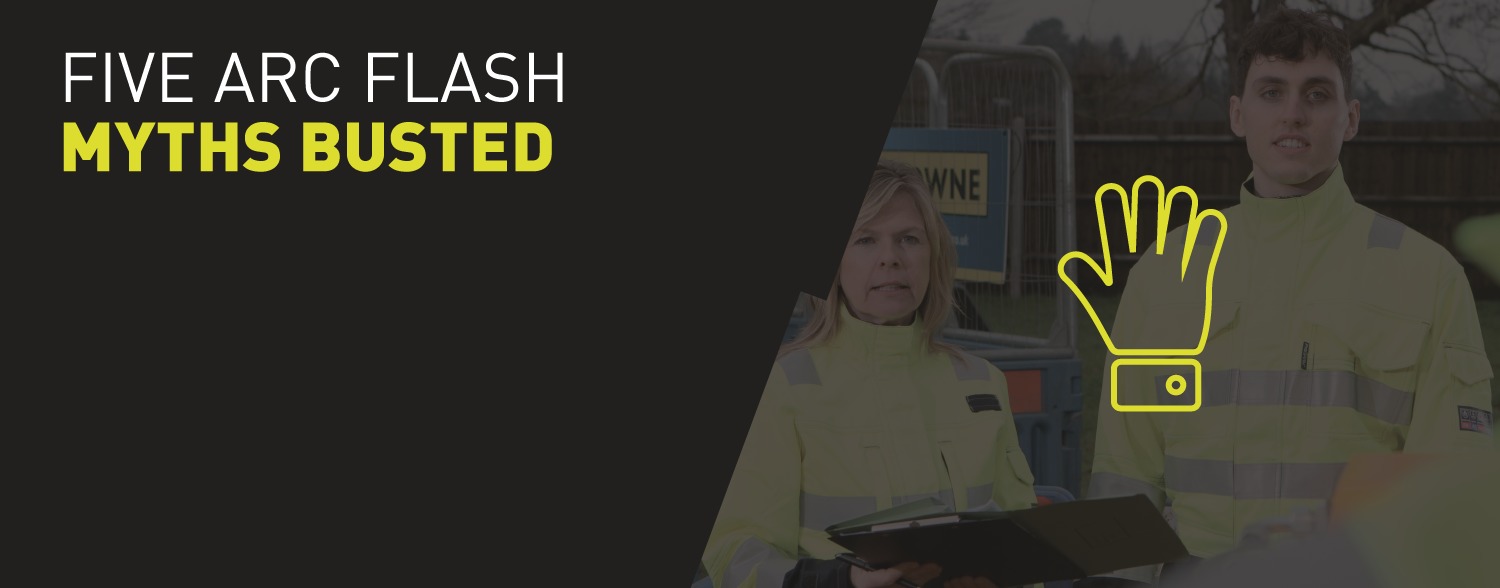
As a lesser-known risk, there are a whole host of Arc Flash myths which are bandied about as truths. Anyone who has worked in environments with an Arc Flash risk knows that these flashes of intense energy are no joke. Presenting a real risk to health and even to life, it’s essential that electricians, electrical engineers and anyone else responsible for or working on electrical switchgear is able to separate fact from fiction. So, what’s the truth?
ARC FLASH MYTH 1 – Arc Flash only happens on high voltage systems
BUSTED – it’s easy to see why this Arc Flash myth has sprung up, and there is some truth in it. Generally, Arc Flashes occur in systems that are 120 volts or higher, but that is not a hard rule. If the conductors are very close together, even a lower voltage level can create an arc flash.
And while a lower voltage Arc Flash, or even just a flash, might not cause the same scale of injuries as a larger flash, they are still a risk. In fact, it can be argued they’re a higher risk, because people are less likely to take the appropriate precautions to protect themselves for “just a spark”.
But if a low voltage Arc Flash comes into contact with a highly flammable material (dust, sawdust, cotton, etc) it can cause a devastating fire.
Systems operating at a higher voltage are going to have greater Arc Flash potential. In very high voltage systems, an Arc Flash can span several feet and trigger explosions.
ARC FLASH MYTH 2 – you don’t need Arc Flash PPE, flame resistant kit will do the job
BUSTED – It would be reasonable to assume that flame retardant (FR) PPE will keep you safe in an incident, but this Arc Flash myth could prove deadly. While FR-rated clothing will work to protect you from flames, it doesn’t protect you from the high-voltage burst of thermal energy that could hit you if you’re unlucky enough to get caught up in an Arc Flash. That blast can throw you across a room and cause a noise that can pierce eardrums and create a light that can blind you.
Arc Flash clothing has separate safety standards that go further than those for fire resistance, and quite rightly. Even if you’re standing six or seven metres away, the extreme heat and energy from an Arc Flash can burn skin and flesh, even without setting clothing on fire.
We also know that the whole garment has to protect you from the effects of an Arc Flash, so our research and development has focused not just on the fabric but on the buttons, zips, Velcro and reflective strips to make sure that they still do their job and will work if the worst happens and you need to take your clothing off to be treated.
ARC FLASH MYTH 3 – Once a piece of equipment has been assessed for arc flash hazard, there’s no need to re-do the study
BUSTED – This one is really dangerous. As we all know, things change over time. Equipment ages, new regulations, information and equipment change the way we do our jobs. Anyone working in an Arc Flash risk environment needs to keep their knowledge and training up to date, assess risk dynamically, deploy equipment safety and make good decisions for themselves and the people around them.
Employers need to make sure training and signage is up to date so all employees have the best, most relevant information available. As part of a comprehensive health and safety strategy, regular assessment and testing should highlight any new or additional risks.
ARC FLASH MYTH 4 – only the person working on the equipment needs to wear Arc Flash PPE
BUSTED – Everyone working in a shock hazard area needs to be protected. Your Arc Flash assessment will calculate the size of the risk and help you determine where your “safe” boundary is, but everyone working within the risk area needs to wear PPE.
People have been the victims of severe burns from five or six meters away from the source of the flash and Arc Flashes aren’t discerning. They won’t only hit the people wearing the right kit.
In addition to the burn risk, pressure waves caused by an Arc Flash can throw people across a room, a sound blast can rupture eardrums and the bright flash can cause temporary or even permanent blindness
ARC FLASH MYTH 5 – As long as you were Arc Flash clothing as your top layer you’ll be protected
BUSTED – All too often, we find people have been misled into believing that wearing standard clothing under an Arc-rated top later of PPE will provide sufficient protection in the event of an Arc Flash. But it’s not enough to rely on an outer layer of protective clothing. During an Arc Flash incident, temperatures can reach 19,000°C. This is hot enough to melt standard clothing, potentially causing significant injuries.
That’s why we recommend those working in high-risk environments wear Arc-rated clothing for every layer.
Not all Arc Flash protective garments are manufactured equal. Whilst many garments meet minimum standards you need to ensure that the level of protection and quality of garment are sufficient to provide the protection the wearer needs. Quality Arc Flash protective garments from ProGARM won’t simply allow you to survive an incident, they will significantly reduce the level of injury that is sustained.
Our Arc Flash personal protective clothing provides more protection than other standard flame-resistant clothing thanks to our exclusive VXS+ fabric. Because it’s made from fibres that have inherent flame-retardant properties, the protection can’t be washed out or fade with wear.
To prove it, we put it to the test. You can see the results for yourself here.
If you want the truth about the latest Arc Flash myth, along with information about what personal protective equipment you need for your team, call our experts on +44 (0) 1482 679600.
This is one post in a series ‘All about Arc Flash’. Continue reading the next in the series or return to the start if you like.
Make sure that you’re specifying the right PPE for your team.
Read our free guide on the top considerations when choosing Arc Flash clothing & PPE below and make the best choice for you and your team via the link below ⬇.
